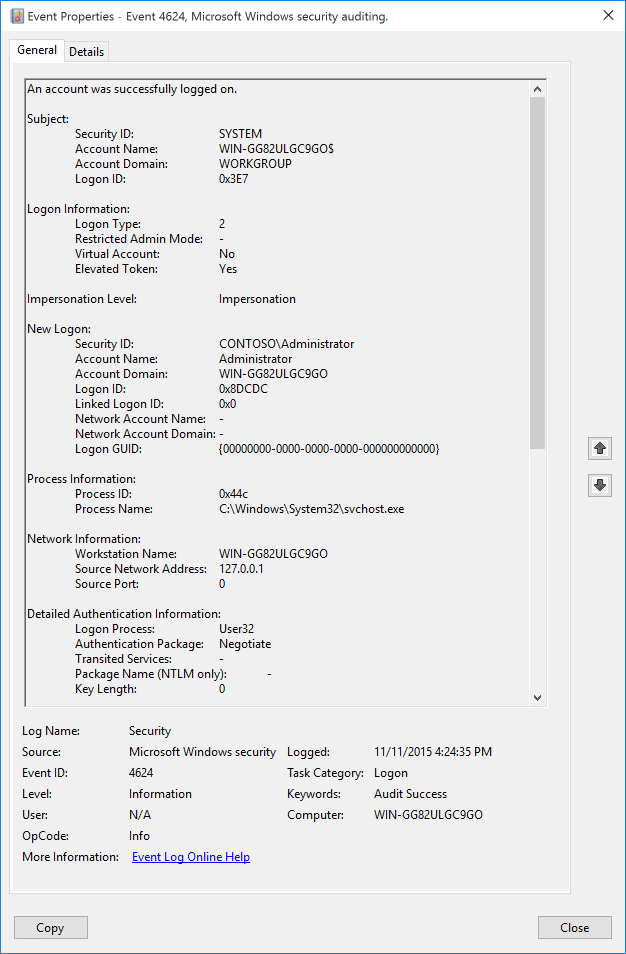

- #ACCOUNT NAME ANONYMOUS LOGON FULL#
- #ACCOUNT NAME ANONYMOUS LOGON PASSWORD#
- #ACCOUNT NAME ANONYMOUS LOGON FREE#
- #ACCOUNT NAME ANONYMOUS LOGON WINDOWS#
Identify-level COM impersonation level that allows objects to query the credentials of the caller.
#ACCOUNT NAME ANONYMOUS LOGON WINDOWS#
This level, which will work with WMI calls but may constitute an unnecessary security risk, is supported only under Windows 2000. Calls to WMI may fail with this impersonation level.ĭelegate-level COM impersonation level that allows objects to permit other objects to use the credentials of the caller. RemoteInteractive (Terminal Services, Remote Desktop or Remote Assistance)ĬachedInteractive (logon with cached domain credentials such as when logging on to a laptop when away from the network)Īnonymous COM impersonation level that hides the identity of the caller. The new logon session has the same local identity, but uses different credentials for other network connections." MS says "A caller cloned its current token and specified new credentials for outbound connections. If you want to track users attempting to logon with alternate credentials see 4648. This logon type does not seem to show up in any events. NewCredentials such as with RunAs or mapping a network drive with alternate credentials. Most often indicates a logon to IIS with "basic authentication") See this article for more information. NetworkCleartext (Logon with credentials sent in the clear text.
#ACCOUNT NAME ANONYMOUS LOGON PASSWORD#
unnattended workstation with password protected screen saver) connection to shared folder on this computer from elsewhere on network) Interactive (logon at keyboard and screen of system) This is a valuable piece of information as it tells you HOW the user just logged on: The 2 logon sessions are connected by the Linked Logon ID described below. So in the log you will see 2 of these events, one where this field is Yes and other No. After you approve the UAC dialog box, Windows runs that one operation under the other logon sesson. Everything you do happens under the unprivileged logon session until you attempt to run something requiring admin authority. One with out the Administrators SID and related privileges in your security token and another session with all that authority. Then when you logon you actually get 2 logon sessions. The "kind of" applies to interactive logons, when you are an admin and you have User Account Control (UAC) enabled. It will be Yes if the user is a member of Administrators - kind of. They're "domain" is "NT Service" as in an instance of MS SQL Server named Supercharger running as NT SERVICE\MSSQL$SUPERCHARGER. You can configure services to run as a virtual account which is what Microsoft calls a "managed local account". Virtual Accounts only come up in Service logon types (type 5), when Windows starts a logon session in connection with a service starting up. This will be Yes in the case of services configured to logon with a "Virtual Account". This field allows you to detect RDP sessions that fail to use restricted admin mode.
#ACCOUNT NAME ANONYMOUS LOGON FULL#
When you remote desktop into a server with /restrictedAdmin you get full authority on that server but it doesn't carry with you if you access other systems from within that RDP session.

You should only see with for logon type 10. Restricted admin mode is an important way to limit the spread of admin credentials in ways they can be harvested by malware using pass-the-hash and related techniques.

Identifies the account that requested the logon - NOT the user who just logged on.
#ACCOUNT NAME ANONYMOUS LOGON FREE#
Free Active Directory Change Auditing Solution.Windows Event Collection: Supercharger Free Edtion.Free Security Log Quick Reference Chart.Win2016/10 add further fields explained below. Win2012 adds the Impersonation Level field as shown in the example. You can tie this event to logoff events 46 using Logon ID. This is a highly valuable event since it documents each and every successful attempt to logon to the local computer regardless of logon type, location of the user or type of account.


 0 kommentar(er)
0 kommentar(er)
